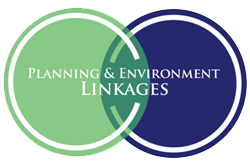
Planning and Environment Linkages
Planning and Environment Linkages (PEL) represents a collaborative and integrated approach to transportation decision-making that 1) considers
environmental, community, and economic goals early in the transportation planning process, and 2) uses the information, analysis, and products
developed during planning to inform the environmental review process.

Who is Involved?
- Transportation planners
- NEPA practitioners
- Resource agency staff involved in conservation planning or NEPA
- Public




Want More Information?
If you are interested in learning more about the PEL program and would like to discuss opportunities for your agency to accelerate project delivery,
you can submit a request.


Benefits of Planning and Environment Linkages
State and local agencies can achieve significant benefits by incorporating environmental and community values into transportation decisions early in planning and carrying these considerations through project development and delivery. Benefits include but are not limited to:
- Relationship-building benefits: The PEL approach enables agencies to be more effective players in the transportation decision-making process through its focus on building interagency relationships. By encouraging resource and regulatory agencies to get involved in the early stages of planning, agencies have an opportunity to help shape transportation projects.
- Improved project delivery timeframes: The PEL approach improves process efficiencies by minimizing potential duplication of planning and NEPA processes, creating one cohesive flow of information. In addition, improvements to inter-agency relationships may help to resolve differences on key issues as transportation programs and projects move from planning to design and implementation.
- On-the-ground outcome benefits: When transportation agencies conduct planning activities equipped with information about resource considerations and in coordination with resource agencies and the public, they are better able to design transportation programs and projects that serve the community's transportation needs more effectively. The PEL approach provides agencies with tools to design better projects while avoiding and minimizing impacts on natural resources.


